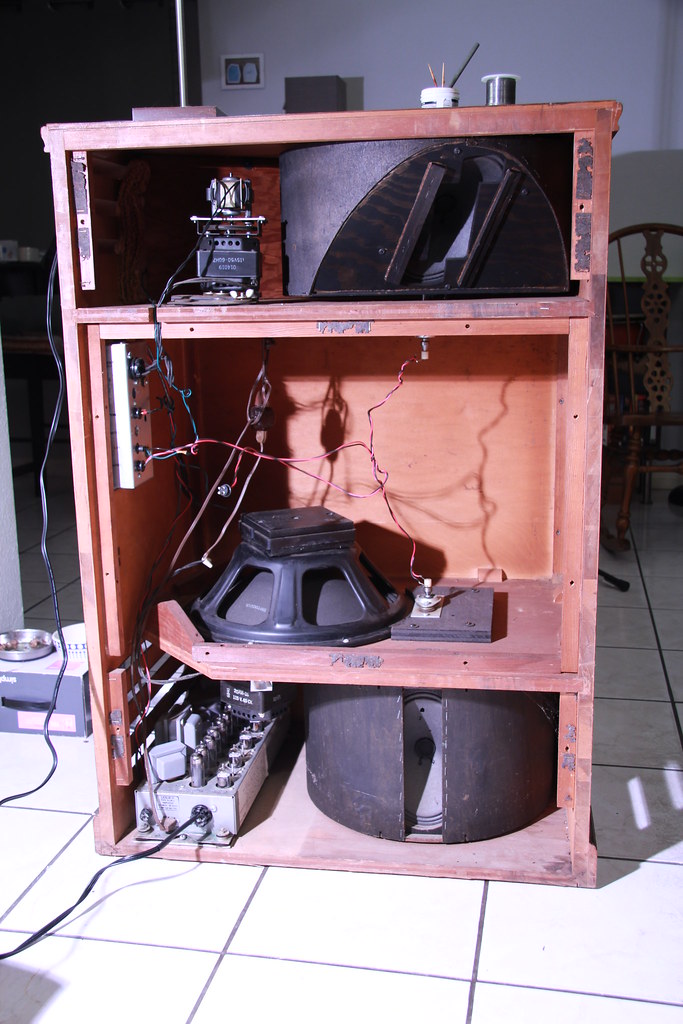I’ve made several tweaks to my electric trumpet setup over the last few months and I’m feeling fired up about the results. Most notably, I managed to score a Leslie rotating speaker off Craigslist, which is a rightous acquisition on many levels. I’ve been at many live shows and studio sessions that used a Leslie for organ amplification and having stood next to one, I can attest that although there are many rotary emulations and good quality recordings of rotating speakers out there, there’s simply nothing like being in the room with the real thing. There’s a rich 3D quality when you hear it in person that needs to be experienced in realtime. For a long time I’ve always thought it would be so cool to have one, and now it’s sitting in my living room!!
My Leslie is a model 205, which is a weird, obscure model. It sat on Craigslist for over a month before I showed up to buy it, probably because it’s a rotosonic model. Rotosonic means that instead of the traditional double horn on top, this model has a rotating drum with a Jensen 6×9 speaker inside of it. Since organs sort of need that screaming, bright sound that a horn gives, most keyboard players would scoff at this substitution. However the trumpet is bright and screamy enough already so the 6×9 speaker works out well for my needs. Here’s an album of pictures I took (click the arrows to see more):

The model 205 is also weird in several other ways as well. It incorporates 5 separate speakers which are independently amplified by a large tube amp and selectable with a relay box. There’s the rotating drum up top with two 6x9s inside (one on each side), another single 6×9 on the bottom inside the rotating drum which spins in the opposite direction, a stationary downward firing 15″ inside the center portion of the cabinet, and a stationary 6×9 which is mounted in one corner on the top. The top drum has a two speed motor for fast and slow rotation and the bottom drum has a fixed, fast-speed motor. The cabinet itself is also slightly unusual, with a different number of louvres than most Leslies and no split in them.
All in all, it’s a total oddball, but one that I think I can configure nicely to fit my own preferences. When I searched for pictures of this model online I could not find any photos of it, only a single video on YouTube from a guitarist who had reconditioned one. For that reason I have posted a lot of photos here in case someone else is trying to research this obscure model. The top drum itself is also different than the bottom drum despite the fact that they appear to hold identical 6×9 drivers. For some reason the designers at Leslie decided the angle the top speakers downward slightly, and added that lightning shaped baffle which partially covers them. Why? It just is. Roll with it.
Getting this Leslie is a major coup for my little home recording operation, and also for the realtime enjoyment of the sounds as they’re being created. It’s gotten me thinking about the major shifts I’ve gone through in the evolution of my electric setup into what it is now. This feels like the beginning of a new era for me. Looking back, I think I could group my setup into three distinct phases:
Version 1 (The Muse Cafe Dawning):
Yamaha Silent Brass as pickup, softshell pedal case on the floor, amplified by a Mesa Boogie wicker-faced guitar amp
Version 2 (The Crystal Gravy Setup):
Audio Technica wireless mic as pickup with feedback suppressor and SWR bass amp for amplification with pedals in a hardshell case on top of a keyboard stand
Version 3 (100% Juice Style):
Barcus Berry brass transducer as pickup, custom wooden pedalboard on top of keyboard stand, SWR bass amp, DI input box for recording pedalboard (later a Behringer mixer), shure SM57 on straight stand for acoustic sound
Version 3.5 (The Acropolis Refinements):
Leslie rotating speaker, PedalGenie rental pedals adding variety, powered Mackie mixer for recording pedalboard, Sennheiser E609 Silver on boom stand for acoustic sound
Anyhow, I’m very excited about this baby. You can hear it on this recent recording which I uploaded to my YouTube channel. It’s being used by the organ in that recording, which is the traditional, easily identifiable way to hear it. Note that the keyboard is not adding its own leslie effect, so the warbling and the tremolo you hear on the organ is all due to this speaker. Man this thing is neat! I’ll have some trumpet recordings with it in the near future…























